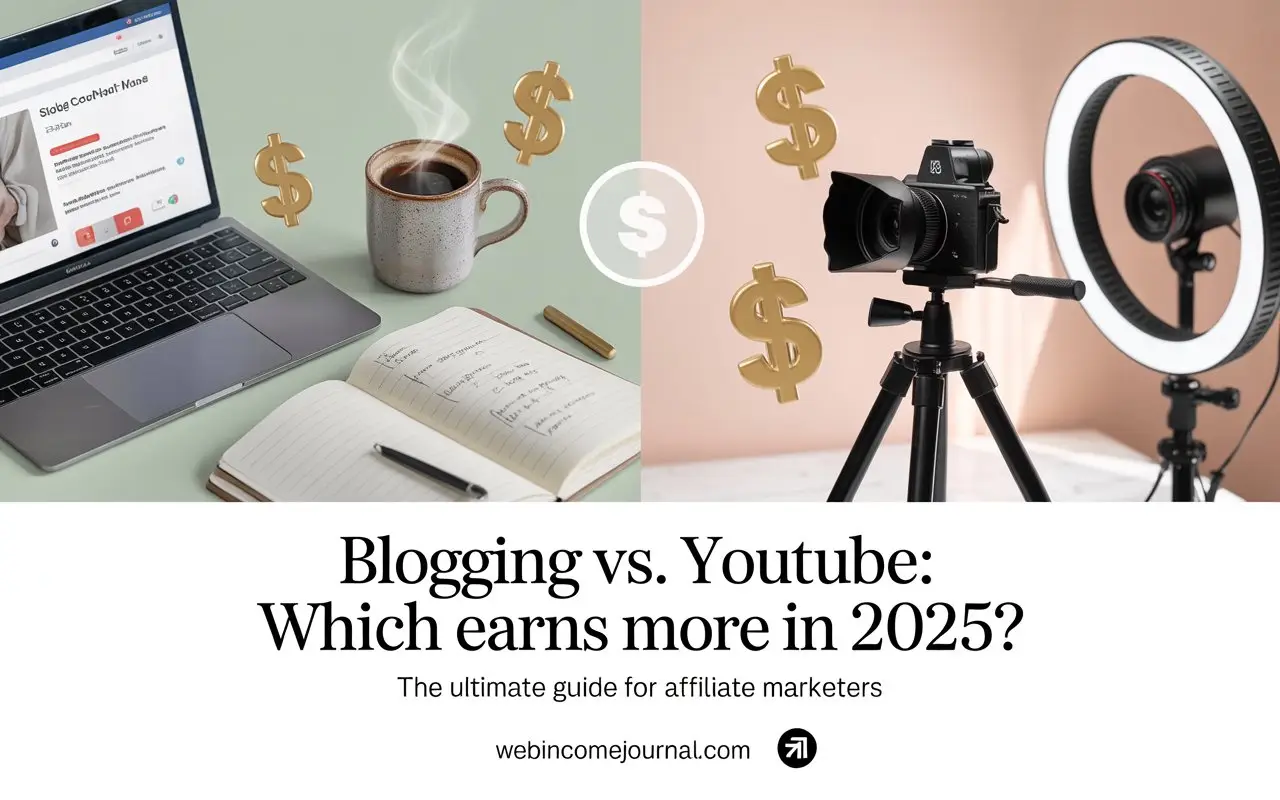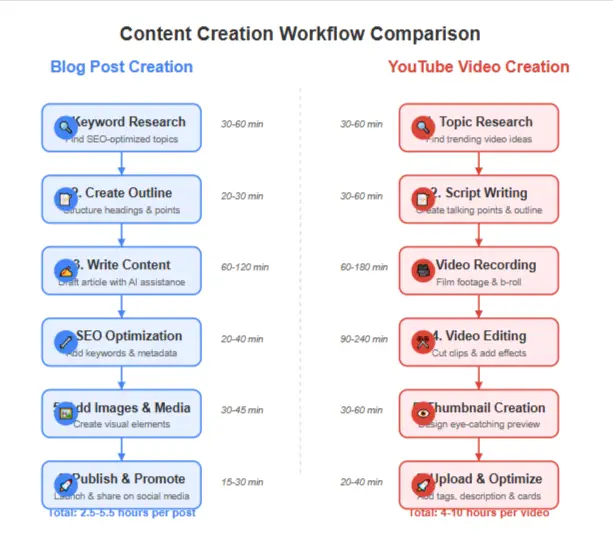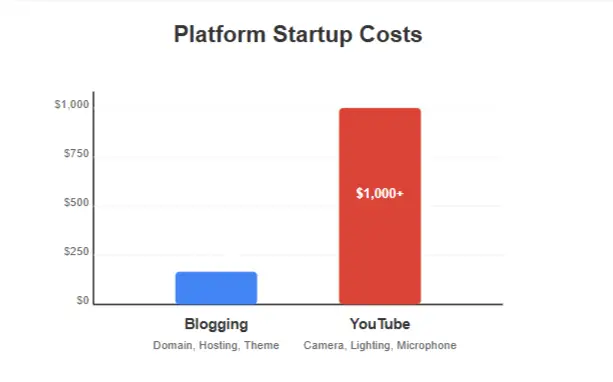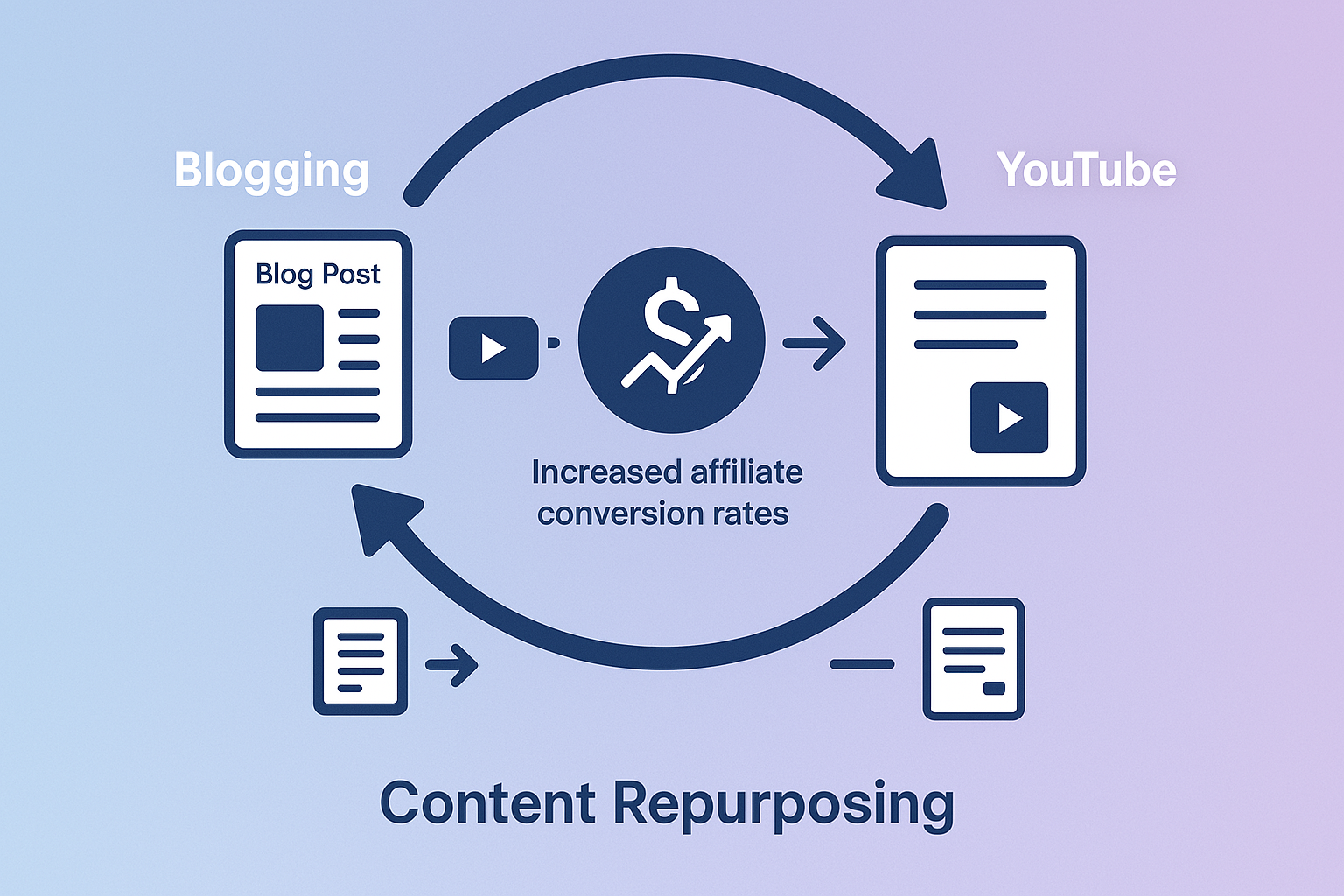
Affiliate marketing has evolved dramatically in recent years. Today, a lot of solo entrepreneurs, side hustlers, and small businesses rely on it as primary revenue stream. Of the many channels available for affiliate marketers for content creation, two platforms dominate the scene: blogging and YouTube.
The question is, should you build a blog, start a YouTube channel, or somehow do both?
If you’re struggling to decide between blogging vs. youtube on where to invest your time and energy to build a sustainable affiliate income stream, this guide breaks down everything you need to know. From costs and skills to case studies, monetization strategies, and the power of combining platforms—we’ve got you covered.
Key Takeaways:
- Blogging gives you SEO power, ownership, and long-term traffic.
- YouTube provides visual authority, faster growth, and deeper engagement.
- Many successful affiliate marketers use a hybrid approach, leveraging both platforms to maximize reach and conversions.
- Use AI tools and repurposing tactics to save time and increase output.
Understanding Affiliate Marketing in 2025
Affiliate marketing is a performance-based model where you promote products or services and earn commissions from resulting sales or leads. But in 2025, the landscape has transformed. It’s more automated, intelligent, and competitive than ever before—and also filled with more opportunity.
- AI-powered tools now assist with everything from selecting profitable affiliate offers to generating blog posts and video scripts that match high-intent search queries.
- Shoppable videos, interactive blog posts, and automated tracking links are redefining how audiences engage with affiliate content.
- Smart affiliates no longer focus on a single channel. Instead, they prioritize user experience and diversify their presence across platforms like YouTube, blogs, email lists, and social media.
In short, affiliate marketing today is less about dropping links and more about building value-driven, platform-optimized content that reaches the right person at the right time.
Affiliate Marketing Key Stats in 2025:
The global affiliate marketing spend in 2024 was over $14 billion and it’s projected to hit $17 billion in 2025. The highest-earning niches including:
- Technology and consumer electronics
- Health and wellness products
- Financial services and fintech
- Home improvement and lifestyle
- Travel and experiences
- AI productivity tools.
More than 60% of top-performing affiliates are now active on YouTube, often integrating it with a blog for greater reach and conversion.
That being said, let’s now dive into comparing the two platforms. Remember however, that successful affiliate marketing on any of these platforms requires quality content that builds trust and provides value to your audience.
Comparing Blogging vs. Youtube for Affiliate Marketing

Blogging for Affiliate Marketers: Pros, Cons, and Strategies
Pros of Blogging
Blogging in 2025 is a content powerhouse when used correctly. With Google continuing to prioritize in-depth, high-quality content, blogs remain a cornerstone of affiliate strategy. The key benefits include:
- SEO dominance: Evergreen blog posts can continue to rank and convert months or years after publishing.
- Low startup cost: A domain and hosting plan cost ~$70/year. Add AI writing tools like ChatGPT, Jasper, or SurferSEO, and you’ve got a powerful publishing machine.
- Monetization flexibility: Use affiliate links, Google AdSense, Ezoic, sponsored content, sell eBooks or digital courses, or build a newsletter for direct offers.
- Content control: You own the site and its design, unlike on social platforms where algorithms dictate visibility.
Cons of Blogging
Despite its strengths, blogging comes with its share of hurdles. However, in 2025, many of these challenges are being tackled head-on by AI tools that streamline SEO, automate content formatting, and even suggest topic ideas tailored to high-converting keywords. Some of these hurdles include:
- Slow initial growth: Organic traffic builds slowly. Most blogs take 6–12 months to gain traction.
- SEO competition: High-authority sites dominate many niches. Finding underserved micro-niches is essential.
- Technical maintenance: You’ll need to manage updates, backups, and plugins if using WordPress.
Overcoming these barriers demands strategic planning and persistence.
Winning Strategies for Blogging
To compete in 2025, smart affiliate bloggers use a mix of tools and tactics:
- Use AI-powered tools like ChatGPT or Claude for content outlines and drafts, SurferSEO for optimization, and Grammarly for tone and grammar.
- Master blog post SEO: include keyword-rich titles, alt-text, internal links, and structured headers.
- Leverage Pinterest and email marketing to drive traffic.
- Repurpose blog posts into YouTube videos, carousels for LinkedIn, or infographics for Instagram.
This approach extends reach while reinforcing your authority across platforms.
YouTube for Affiliate Marketers: Pros, Cons, and Strategies
Pros of YouTube
YouTube is a high-conversion platform for affiliate marketing in 2025, thanks to its visual nature and growing user base. Creators can showcase products through affiliate-friendly content types like unboxings, tutorials, comparisons, and honest reviews—formats that naturally build trust and drive purchases. Its key benefits include:
- Faster audience growth: Videos can go viral, especially with YouTube Shorts and trending topics.
- Built-in monetization: Ads (via the YouTube Partner Program), Super Chats, Memberships, Sponsorships, and Shorts Fund.
- Higher trust factor: Seeing a real person talk about a product builds immediate credibility and trust. According to WeCanTrack, viewers are 35% more likely to purchase a product after seeing it demonstrated in a video
- Engaged community: Comments, likes, and subscriber notifications build strong fan loyalty.
Cons of YouTube
While the platform rewards effort, it’s however not plug-and-play. Here are some of the drawbacks of the Youtube for affiliate marketing:
- High production costs: Quality video requires decent gear (camera, mic, lights) and editing software (e.g., Adobe Premiere Pro, Final Cut Pro). Total startup costs typically exceed $1,000, plus ongoing time investment in editing.
- Platform dependency: You’re at the mercy of the YouTube algorithm 2025, which may limit reach if your niche isn’t “hot.”
- Monetization delay: You can’t monetize with ads until you reach 1,000 subscribers and 4,000 watch hours.
- Content may face demonetization for sensitive topics
- Affiliate links must comply with platform disclosure requirements
- Time-intensive: Planning, scripting, filming, and editing a single video can take 6–10 hours.
These factors limit control compared to owning a blog.
Winning Strategies
Standing out in the Youtube space requires more than just uploading a few videos. You need a strategy that prioritizes discoverability, audience retention, and consistent value. Here’s what to do:
- Nail your YouTube SEO: Include target keywords in titles, use optimized thumbnails, and hook viewers in the first 15 seconds.
- Use TubeBuddy and VidIQ to analyze competitors and optimize your channel.
- Batch film your content and use Pictory.ai to repurpose long videos into Shorts or reels.
- Add clear calls to action in the description box with affiliate links, discount codes, or links to your email opt-in page.
Leveraging YouTube Shorts for Affiliate Promotion
YouTube Shorts offers a fast-growth opportunity:
- Create 60-second product highlights
- Demonstrate quick tips using affiliate products
- Share before/after results
- Use Shorts to funnel viewers to full reviews
Many creators report 10x the reach through Shorts compared to traditional videos.
Head-to-Head Comparison: Key Factors for Affiliate Success
1. Initial Investment
| Factor | Blogging | YouTube |
| Startup Costs | $70-200/year | $1,000+ equipment + ongoing costs |
| Time to First Revenue | 3-6 months (typical) | 2-3 months (if growing well) |
| Time Investment | 2-4 hours per post | 4-8 hours per video |
| Technical Learning Curve | Medium (WordPress, SEO) | Medium-High (filming, editing) |
Best for Budget Constraints: Blogging offers the lowest financial barrier to entry.
2. Skill Requirements
Blogging Success Requires:
- Strong writing abilities
- SEO knowledge and keyword research
- Basic web design/WordPress skills
- Data analysis for content performance
YouTube Success Requires:
- On-camera presence and personality
- Video shooting and production skills
- Thumbnail design and video editing
- Public speaking and presentation abilities
Best for Natural Communicators: YouTube rewards personality and presentation skills.
3. Audience Engagement
Blog Readers:
- Often have higher purchase intent (searching for solutions)
- Consume content at their own pace
- Engage through comments and sharing
- Return through bookmarks and newsletters
YouTube Viewers:
- Build stronger personal connection with creators
- Engage through likes, comments, and subscriptions
- Share content more frequently
- Follow creators across multiple platforms
Best for Building Community: YouTube creates stronger personal connections.
4. Content Longevity
Blog Posts:
- Can rank for years with minimal updates
- Benefit from accumulated backlinks over time
- Support historical optimization for improved rankings
- Build domain authority with age
YouTube Videos:
- May see viewing decline after initial promotion
- Can resurface through algorithm recommendations
- Require thumbnails/titles updates to stay relevant
- Build channel authority with consistent uploads
Best for Long-Term Assets: Blogging creates more durable content assets.
5. Monetization Flexibility

Blog Monetization Options:
- Multiple ad networks (not platform-dependent)
- Unlimited affiliate links throughout content
- Digital product sales without platform fees
- Email list building for direct marketing
YouTube Monetization Options:
- Ad revenue sharing with YouTube
- Limited affiliate link placement (description only)
- Channel memberships (requires qualifications)
- Merchandise shelf integration
Best for Monetization Freedom: Blogging offers greater control and flexibility.
Case Studies: Real-World Success Stories
1. Blogging Success: Finance Niche
Sarah started a personal finance blog in 2023 focusing on credit card rewards and investment strategies. After 18 months of consistent publishing:
- Monthly traffic: 75,000 visitors
- Revenue streams:
- Affiliate commissions: $6,500/month
- Display ads (Ezoic): $2,100/month
- Digital course sales: $1,200/month
- Total monthly income: $9,800
Key success factors:
- Comprehensive comparison posts (3,000+ words)
- Regular content updates to maintain rankings
- Strong email nurturing sequence for affiliates
- Strategic interlinking between related content
Sarah notes: “The slow start was frustrating, but the compound growth and passive nature of blog income has been worth the patience.”
2. YouTube Success: Tech Reviews
Marcus launched a tech review channel in 2023, focusing on smartphone accessories and productivity apps. After 18 months:
- Subscriber count: 185,000
- Revenue streams:
- Affiliate commissions: $8,700/month
- YouTube ad revenue: $3,200/month
- Sponsored content: $5,000/month
- Total monthly income: $16,900
Key success factors:
- Consistent twice-weekly posting schedule
- High-quality production value
- Strategic use of YouTube Shorts for growth
- Brand relationship development for exclusive deals
Marcus shares: “The equipment investment was significant, but the personal connection with viewers drives much higher conversion rates for my affiliate recommendations.”
Hybrid Approach: Combining Blogging and YouTube

As we have seen from above, blogging and Youtube have their strengths and weaknesses. The good things is that instead of limiting yourself to just one you can actually combine the two. This is a better strategy in today’s fast-paced content landscape. Limiting yourself to just one platform could mean leaving traffic and income on the table. However, by blending the strengths of blogging and YouTube, you can reach different audiences, diversify your traffic sources, and build a more resilient affiliate marketing business.
The hybrid approach allows you to leverage the search engine visibility of blog posts and the high engagement and trust factor of videos—giving you the best of both worlds. Here’s a simple guide to do this:
Step 1: Start with your strength
- If writing comes naturally, launch a blog first.
- If you’re confident on camera, start with YouTube.
- Focus on one, master it, then expand.
Step 2: Repurpose content across platforms
- Convert blog posts into YouTube scripts.
- Record yourself reading blog content as a video.
- Use Canva to turn blog points into carousels or reels.
- Embed videos in blog posts to increase time on page, a key Google ranking signal.
Step 3: Build an ecosystem
- Promote videos on your blog, and promote blog links in your video descriptions.
- Collect emails from both platforms using lead magnets.
- Use tools like ConvertKit or MailerLite for automation.
Hybrid Toolkit:
| Tool | Purpose |
| Canva | Thumbnails, social media content |
| Pictory.ai | Turn blogs into videos |
| Jasper | Generate repurposed copy |
| Buffer | Cross-platform scheduling |
| Ahrefs | Keyword research for blogs and videos |
| Drive traffic to blog posts |
A hybrid strategy typically increases affiliate conversion rates by 25-40% compared to single-platform approaches.
Choosing the Right Platform: Key Questions to Ask Yourself

Choosing between blogging and YouTube isn’t just about preference—it’s about aligning your content creation with your strengths, resources, and long-term vision. Asking the right questions upfront will help you avoid wasted effort and set you on a path to consistent affiliate success.
Answer these questions honestly to determine your ideal starting platform:
Skills Assessment:
- Do you enjoy writing more than speaking on camera?
- Are you comfortable learning video editing software?
- Do you have strong analytical skills for SEO?
- Do you have a natural on-camera personality?
Resource Evaluation:
- Do you have $1,000+ available for video equipment?
- Can you wait 6+ months for significant blog traffic?
- Do you have 5-10 hours weekly for content creation?
- Do you have quiet space for video recording?
Niche Considerations:
- Does your niche benefit from visual demonstrations?
- Are your target keywords highly competitive in search?
- Are there successful affiliate marketers in your niche on both platforms?
- Does your audience prefer reading or watching content?
Long-Term Goals:
- Are you building a personal brand or faceless authority?
- Do you want to eventually sell your content platform?
- Are you seeking passive income or active engagement?
- Do you plan to expand into other business models?
Decision Flowchart
- Love writing + Tight budget = Go Blog
- Love video + Visual storytelling skills = Go YouTube
- Balanced skills + Growth ambition = Combine both
Conclusion: Which Platform Should You Choose?
In this post we’ve seen that both blogging and YouTube are powerful for affiliate marketing. Blogging excels in searchability and control, while YouTube leads in trust and engagement. Choosing the right one depends on how you prefer to create, how you connect best with your audience, and how quickly you want to grow.
For most affiliate marketers starting in 2025, the most practical approach is:
- Begin with a single platform that matches your strongest skills
- Build systems and consistent content for 6-12 months
- Expand to the second platform by repurposing existing content
- Develop cross-promotion strategies between platforms
Remember that consistency and quality matter more than platform choice. Whichever path you choose, focus on creating valuable content that genuinely helps your audience solve problems or make informed purchasing decisions.
Your success as an affiliate marketer ultimately depends on the trust you build with your audience—something that transcends any specific platform.
FAQs: Blogging vs. YouTube for Affiliate Marketing
-
How long until I make money from affiliate marketing?
With consistent quality content, YouTube typically generates initial commissions in 2-3 months, while blogs often take 4-6 months to see significant affiliate revenue.
-
Which platform has better long-term sustainability?
Blogs generally have longer content lifespan and more stable traffic, while YouTube success depends more heavily on algorithm changes and continued production.
-
Can I succeed without showing my face on YouTube?
Yes. Many successful channels use screencasts, animations, or product-only footage, though showing your face typically builds stronger audience connection.
-
What’s the minimum posting frequency for success?
For blogs, 1-2 quality posts weekly is sufficient. For YouTube, 1 weekly video plus 2-3 Shorts can build momentum effectively.
-
Is it better to focus on one niche or cover multiple topics?
For faster growth and stronger affiliate conversions, focusing on a specific niche is generally more effective on both platforms.







This was an incredibly insightful and well-researched comparison—thank you for breaking it down so clearly! The hybrid approach especially stood out as a powerful strategy. One question though: for someone starting solo with limited time, which platform would you recommend focusing on first to build momentum faster?
Considering the recent changes in the SEO landscape, I’ll advise you start with Youtube if you want to build momentum faster.
“Great read! I really enjoyed how you explained the topic in such a clear and engaging way. The insights and examples made it easy to understand. Looking forward to more amazing content from you!”
I have read this content it is very nice with unique content and keep updating us.
This was an incredibly insightful and well-structured comparison—thank you for breaking it down so clearly! I appreciate how you highlighted both the strategic and technical sides of blogging and YouTube for affiliate marketing in 2025. The stats and actionable tips were especially helpful. I’m curious—if someone is just starting and has limited time, would you recommend focusing on YouTube Shorts first or building a niche blog?
Great Information Provided Thanks For The Information !
Hi, Your blog is really very informative and useful for me. Thanks for sharing this valuable blog.